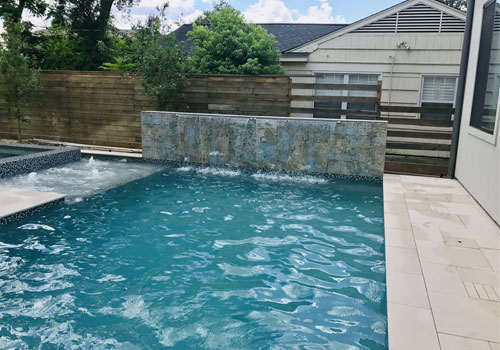Excavating for your pool begins with using a bobcat tractor to create a precise shape and curvature. The hole will be slightly larger than the final dimensions of the pool to accommodate forming material around the edges. Additionally, the bond beam will be a 12" x 12" dimension around the top of the pool. Any excess dirt or soil will be removed on the same day as the excavation. If you wish to keep any dirt or mud on site, please arrange with us beforehand for proper dumping.
A reinforcement bar, or ReBar, is an essential component in pool construction. Made of 3/8"
diameter steel, ReBar is tied together to create a mesh framework on the floor and walls of your pool. This framework provides much-needed strength and stability to the structure. In pool construction, ReBar is placed at 8" centers throughout the pool. This means that the bars are evenly spaced every eight inches apart, ensuring uniform distribution of strength and support.
The ReBar is used not only at the bottom of the pool but also extends up the sides, around the
skimmer, and into the bond beam, also known as the box beam. To further enhance the strength of the bond beam, which is crucial for structural integrity, a larger 1/2" diameter ReBar is used. This ensures maximum reinforcement in the critical areas of the pool.
An essential aspect of ReBar placement is the use of spacers. These spacers are used to suspend the ReBar above the ground, preventing direct contact with the dirt floor of the pool. Similarly, ReBar in the walls is spaced from the dirt sides. This precautionary measure ensures that the ReBar remains protected and provides optimum reinforcement. The ReBar system allows for applying gunite, a popular pool construction material. Gunite is sprayed over the ReBar, and the bars act as a framework, ensuring that the gunite is evenly distributed under, around, and above the ReBar. This results in a strong and durable pool structure.
During construction, small tie wires are used to temporarily hold the ReBar in place until the
gunite is applied. These ties are not permanent and are only meant to secure the ReBar during construction. Despite its seemingly insignificant appearance, ReBar plays a vital role in the strength and stability of your pool. When combined with the powerful components of gunite, Rebar forms the backbone of your pool, providing longevity and resilience.
The plumbing and electrical stub-out is a crucial step during the pool construction process. Stub-
out refers to installing significant plumbing and electrical components inside the wall, which will be finished later. We will use non-corrosive schedule 40 PVC plumbing pipes and fittings throughout your pool for superior durability.
Our skilled plumbers will carefully place the pipes according to your pool plan, ensuring optimal functionality. In addition to the plumbing, our electricians will install the necessary wiring from your electric panel to the equipment. From there, the wiring will extend to all the lighting fixtures and equipment in your Houston pool.
Ensuring your safety is our top priority. Our electric wiring, conduit, and grounding devices not only meet but exceed the standards set by the National Electric Code. We go above and beyond by installing the latest state-of-the-art ground fault interrupter devices for enhanced protection against electrical faults.
Gunite is a pneumatically applied material used to create the pool shell. It is applied to both sides of the ReBar, which helps form a solid structure. To ensure proper curing, the gunite must be watered three times daily for seven to ten days. This helps prevent shrinkage cracks from forming due to premature curing.
Bull Nosed or Safety Grip Brick, Flagstone, Marble, or Slate. Changes may incur extra costs—no post-installation changes to coping.
Rockwork for water features, retaining walls, and natural boulders around your pool will be
installed. The water features will be tested for proper operation and plumbing installation.
All construction debris will be cleared from the pool and its surroundings. If the exterior fence is removed, it will be reinstated as required by local regulations for pool safety barriers against unauthorized access by children.
At this stage, the pool surface will be plastered. Our team will mix the plaster on-site and apply
two coats; carefully hand troweled to create a non-slip waterproof finish. Once the plastering is done, we will immediately start filling the pool or spa. Please have your garden hose ready for serving to make this process smoother.
To reach the desired water level, fill the pool until the water comes from either the center of the waterline tile or the center of the skimmer. Once the water level is reached, you can turn off the water. Avoid turning off the water during the filling process, as this can cause a bathtub-like ring and stain the plaster.
Get ready to make a splash! Your pool is complete, and it's time for the exciting start-up process. Our experienced team will take care of the initial start-up of your pool equipment, ensuring everything runs smoothly. To clear the water of any plaster dust or sediments, your pool equipment needs to remain operational for an entire week. Don't worry; we've got you covered with our professional start-up service.
But that's not all. We want to ensure you have all the knowledge you need to maintain your pool and keep it in pristine condition. That's why we offer Pool School, where our representatives will provide you with valuable instructions, explanations, and hands-on demonstrations.
In order to meet pool safety regulations, any construction debris found inside or outside the swimming pool area will be removed. If the exterior fence was removed during construction, it will be reinstalled as municipalities mandate pool safety barriers to prevent children from accessing the pool.

